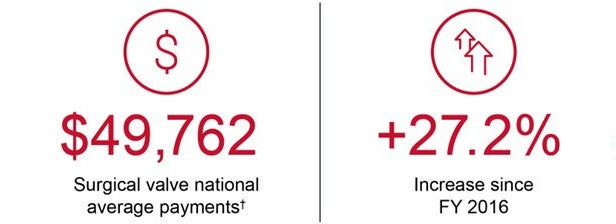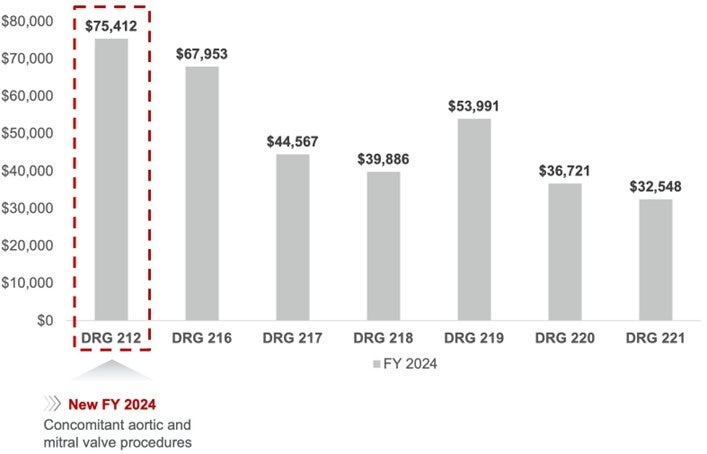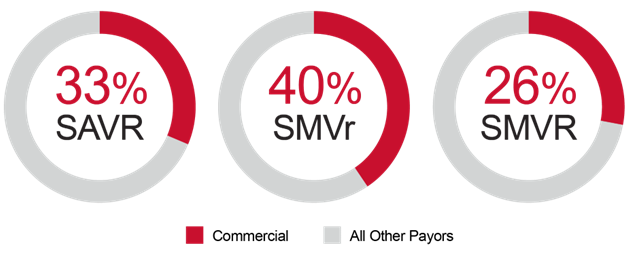The Surge

Strong reimbursements enable surgeons and patients to consider innovative solutions

With robust commercial insurance reimbursements and a generally upward trajectory of Medicare reimbursements, cardiac surgical valve procedures remain a strong service line for US hospitals.
These trends are also encouraging for surgeons and their patients. They allow for more comprehensive discussions around valve options and technology, ensuring more appropriate options are likely to be included.
With shared decision-making being a focal point of the latest guidelines,1 the vital role surgeons play has become even more essential.
Increasing reimbursements for surgical valve procedures2
Medicare has historically been the most common payer among surgical valve repair and replacement procedures and has recently released its reimbursement rates for FY 2024.
Medicare Severity Diagnosis Related Group (MS-DRG) payments for surgical valve procedures have increased by 27.2% since 2016, enabling surgeons and patients to consider innovative solutions.
Surgical valve Medicare national average payments3
(weighted average of MS-DRGs 216 -221)

†FY 2024 Weighted average inclusive of newly created DRG 212 (concomitant aortic and mitral procedures).
Medicare FY 2024 national average base payment rates3

In the Inpatient Prospective Payment System final rule for FY 2024 Medicare has introduced a newly created MS-DRG 212 for concomitant aortic and mitral valve procedures.
Commercial insurance payments are higher than Medicare
Cardiac procedures, particularly surgical valve procedures, can positively contribute to hospital margins. Medicare payments are strong across all MS-DRGs associated with surgical valve procedures.
However, commercial payments for these procedures are higher than Medicare payments. Additionally, the payer-mix may shift in the future as transcatheter treatment options continue to evolve.3,4
National payer mix for surgical valve procedures5

How much higher are commercial payments (age< 65years) vs Medicare for valve procedures?6,7

SAVR = Surgical aortic valve replacement, SMVr = Surgical mitral valve repair, SMVR = Surgical mitral valve replacement
The reimbursement landscape is evolving, and surgical valve procedures stand to benefit. Medicare’s recent guidance ensures that reimbursement updates accurately mirror the evolving treatment landscape, providing necessary treatment for patients needing simultaneous/concomitant valve repair and replacement during the primary procedure.
Lastly, the rise of patients with commercial insurance may contribute to increased reimbursement for the surgical valve service line among US hospitals.
Trends like these make it increasingly possible to consider innovative technologies that address patients' clinical needs and meet their shared decision-making priorities.
Explore all available technologies with your patients to select the most suitable option that aligns with their values, preferences, and goals.
Get our helpful guide to review reimbursement by payer class (Medicare, Commercial, & Medicaid) and understand payer-mix for surgical valve procedures.
Important- Please Note: This information is provided as a general resource and is not intended to constitute medical advice or in any way replace the independent medical judgment of a trained and licensed physician with respect to any individual patient needs or circumstances. Coverage, reimbursement, and health economics information provided by Edwards is gathered from third-party sources and presented for illustrative purposes only. This information does not constitute reimbursement or legal advice, and Edwards makes no representation or warranty regarding this information or its completeness, accuracy, or timeliness. Laws, regulations, and payer policies concerning reimbursement are complex and change frequently; service providers are responsible for all decisions relating to coding and reimbursement submissions

As a member of the Advanced Medical Technology Association (“AdvaMed”), Edwards Lifesciences strictly adheres to the requirements of the AdvaMed Code of Ethics on Interactions with Health Care Professionals. If required by law (US Sunshine Act), Edwards will disclose the value of any meals, travel and/or educational items provided to you in connection with this program, and Edwards also may publish such information on its website or other public manner in order to provide the public with full disclosure of its financial arrangements with health care professionals.
References
- Otto CM, Nishimura RA, Bonow RA, et al. 2020 ACC/AHA Guideline for the Management of Patients With Valvular Heart Disease: A Report of the American College of Cardiology/American Heart Association Joint Committee on Clinical Practice Guidelines. Circ 2021;143(5):e72-e227.
- Agency for Healthcare Research and Quality (AHRQ). Healthcare Cost and Utilization Project (HCUP) 2019 National Statistics, Payer-mix data.
- Commercial, Medicare and Medicaid data: National Inpatient hospital dataset of all-payor data from 241 facilities (October 2020 to September 2021).
- FY 2016, ’17, ’18, ’19, ’22, ’23, 'and 24 Final rules and FY 2020, ‘2021 IPPS Final rules – Correction Notice.
- Agency for Healthcare Research and Quality (AHRQ). Healthcare Cost and Utilization Project (HCUP) 2019 National Statistics, Payer-mix data.
- Mori M, Gupta A, Wang Y, et al. Trends in Transcatheter and surgical aortic valve replacement among older adults in the United States. J Am Coll Cardiol. 2021 Nov;78(22):2161–72.
- Sharma T, Krishnan AM, Lahoud R. National trends in TAVR and SAVR for patients with severe isolated aortic stenosis. J Am Coll Cardiol. 2022 Nov;80(21):2054-56.
Edwards, Edwards Lifesciences, and the stylized E logo are trademarks of Edwards Lifesciences Corporation or its affiliates. All other trademarks are the property of their respective owners.
© 2024 Edwards Lifesciences Corporation. All rights reserved. PP--US-9740 v1.0
Edwards Lifesciences • One Edwards Way, Irvine CA 92614 USA • edwards.com
